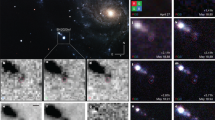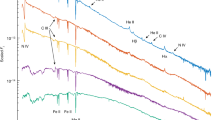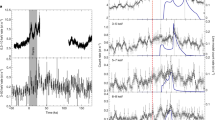Abstract
Supernova (SN) 1982g in NGC1332 was discovered by Maza on 28 March 1982 at mpg=14.0 (ref. 1) some 30kpc (Ho = 50 km s−1 Mpc−1) from the nucleus of the parent galaxy (distance, 30Mpc; type, SO)2. No other optical data have been reported so the SN type is uncertain, although no Type II SN has ever been identified in a galaxy earlier than SA3. We have obtained IR light curves for SN 1982g covering 100–250 days after its discovery. We show here that the IR radiation is due to heated dust. No evidence has been found for grain condensation in the SN ejecta. In fact, the light curves reveal that the IR emission originates from a pre-existing circumstellar dust cloud and is produced by an ‘echo’ of the UV and visible pulse of the SN.
This is a preview of subscription content, access via your institution
Access options
Subscribe to this journal
Receive 51 print issues and online access
$199.00 per year
only $3.90 per issue
Buy this article
- Purchase on Springer Link
- Instant access to full article PDF
Prices may be subject to local taxes which are calculated during checkout
Similar content being viewed by others
References
Maza, J. IAU Circ. No. 3684 (1982).
de Vaucouleurs, G. & de Vaucouleurs, A. Second Reference Catalogue of Bright Galaxies (University of Texas Press, 1976).
Cowal, C. T. The Palomar Supernova Search Master List (Caltech, 1982).
Merrill, K. IAU Circ. No. 3444 (1980).
Dwek, E. et al. Bull. Am. astr. Soc. 13, 795 (1981).
Chevalier, R. A. Astrophys. J. 251, 259–265 (1981).
Cernuschi, E., Marsicano, F. & Codina, S. Ann. Astrophys. 30, 1039–1051 (1967).
Hoyle, F. & Wickramasinghe, N. C. Nature 226, 62–63 (1970).
Bode, M. F. & Evans, A. Astr. Astrophys. 73, 113–120 (1979).
Weiler, K. W., Sramek, R. A., van der Hulst, J. M. & Panagia, N. in Supernovae: A Survey of Current Research, 281–291 (Reidel, Dordrecht, 1982).
Branch, D. et al. Astrophys. J. 244, 780–804 (1981).
McMillan, R. S. & Tapia, S. Astrophys. J. Lett. 226, L87–L89 (1978).
Morrison, P., & Sartori, J. Astrophys. J. 158, 541–570 (1969).
Colgate, S. A., Petschek, A. K. & Kriese, J. T. Astrophys. J. Lett. 237, L81–L85 (1980).
Panagia, N. et al. Mon. Not. R. astr. Soc. 192, 861–879 (1980).
Draine, B. T. Astrophys. J. 245, 880–890 (1981).
Rowan-Robinson, M. & Harris, S. Mon. Not. R. astr. Soc. 200, 197–215 (1982).
Dwek, E. Astrophys. J. (in the press).
Author information
Authors and Affiliations
Rights and permissions
About this article
Cite this article
Graham, J., Meikle, W., Selby, M. et al. Discovery of an IR echo from a supernova dust cloud. Nature 304, 709–710 (1983). https://doi.org/10.1038/304709a0
Received:
Accepted:
Published:
Issue Date:
DOI: https://doi.org/10.1038/304709a0
This article is cited by
-
Old cold dust heated by supernova 1987A
Nature (1989)
-
Pre-existing dust shells around type-I supernovae
Astrophysics and Space Science (1985)
Comments
By submitting a comment you agree to abide by our Terms and Community Guidelines. If you find something abusive or that does not comply with our terms or guidelines please flag it as inappropriate.



